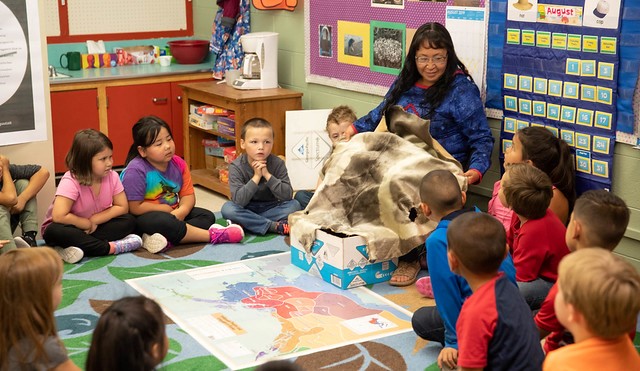
November 22, 2021
Dear Colleagues,
Native American Heritage Month is an opportunity to recognize the innovative ways in which Native American, Native Hawaiian, and Alaska Native educators have fostered educational equity, resilience, and self-determination in their communities. Within the Rural, Insular, and Native Achievement Programs (RINAP) division, this month we wish to highlight a few Alaska Native Education and Native Hawaiian Education program accomplishments.
RINAP provides financial support and technical assistance to improve the educational outcomes of students, particularly students in rural and geographically isolated areas. Many RINAP grantees serve a cross section of Native American, Native Hawaiian, and Alaska Native students educated in rural and geographically isolated communities. These students are educated by teachers, parents, and elders; through technology and distance learning, as well as in-person through apprenticeships and storytelling; in small, rural school districts as well as in cities like Anchorage and Honolulu. Below you can learn more about RINAP and the grantees we support.
Alaska Native Education Program
The purpose of the Alaska Native Education program is to meet the unique education needs of Alaska Natives and to support supplemental education programs to benefit Alaska Natives. The 82 grants currently funded support a wide range of activities, including the creation of culturally informed curricula, professional development for educators, and early childhood education activities designed to improve the school readiness of Alaska Native children.
This year, the Department funded $100 million in new projects, enabling Alaska Native Education grantees to adopt creative implementation strategies to better meet the unique needs of Native students in rural and geographically isolated areas during the COVID-19 pandemic. One example of a recently completed project is Fairbanks Native Association’s Johnson-O’Malley Early Learners project, which helped improve school attendance among previously disconnected students through culturally grounded instruction and the use of online resources to improve children’s skills in the Koyukon-Athabascan language Denaakk’e. Another example, Yukon-Koyukuk School District’s Tech Boost project, received funding this year and plans to mitigate the effect of students’ limited access to broadband by developing non-Internet dependent remote learning materials and technology, such as tablets pre-loaded with academic software for use at home.
Native Hawaiian Education Program
The purpose of the Native Hawaiian Education program is to develop innovative education programs to assist Native Hawaiians and to supplement and expand programs and authorities in the area of education. Grantees address the needs of learners of all ages, ranging from the operation of community-based learning centers for Native Hawaiian children and families to postsecondary counseling, guidance, and support services.
During the COVID-19 pandemic, Native Hawaiian Education grantees were forced to respond quickly to COVID-19 related school closures, with many grantees pivoting from their planned service delivery strategy. For instance, Laʻiʻōpua 2020 developed virtual classes for K-7 students that paired Hawaiian language instruction with hula, ukulele, cooking, and art courses, in addition to an in-person Hawaiian language instruction summer program. Most of the $85 million in projects that the Department funded this year have plans to address COVID-19 impacts,
…including University of Hawaiʻi’s Hawaiʻi Positive Engagement Project (H-PEP), a new 2021 grant that seeks to address the toxic stress present in parents and educators brought about by the COVID-19 pandemic, so that these key adults are the most effective when working with and parenting children. H-PEP plans to implement a variety of strategies to build well-being and resilience and reduce stress, including fostering communities of practice through online support cohorts, facilitating virtual retreats, and holding in-person “Innovation Celebrations,” where participants will showcase their well-being-focused Community Action Plans.
As we approach the end of November, we encourage you to visit the Native American Heritage Month website to learn more about the events that have occurred this month, which kicked off with an interview of Joy Harjo, the first Native American U.S. Poet Laureate and Deb Haaland, the first Native American cabinet secretary. We also thank all RINAP grantees for their efforts to better serve Native American, Alaska Native, and Native Hawaiian students, families, communities, and Tribal Nations.
Happy Native American Heritage Month!
Regards,
Patrick Carr
Director
Rural, Insular, and Native Achievement Programs
Office of Elementary and Secondary Education | U.S. Department of Education
400 Maryland Ave. SW | Rm. 3E206 | Washington, DC 20202
ph. 202.708.8196 | patrick.carr@ed.gov
